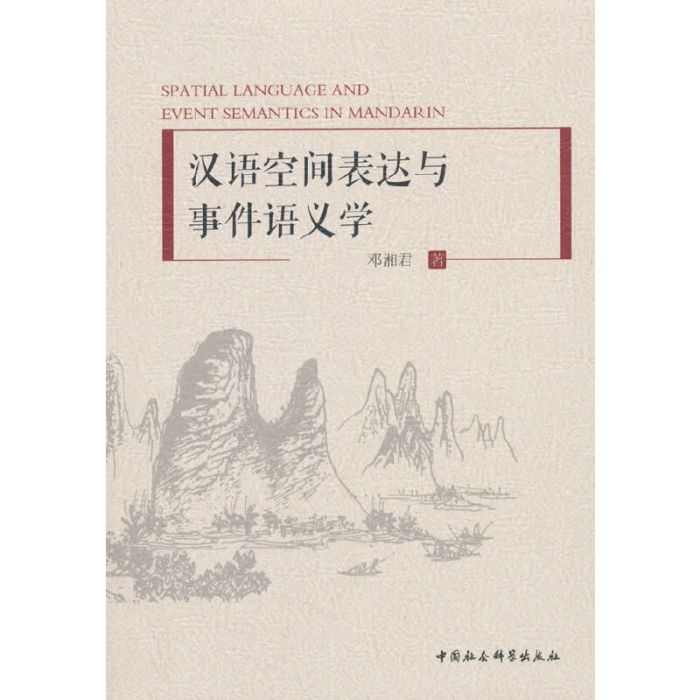《漢語空間表達與事件語義學》是2018年09月中國社會科學出版社出版的圖書,作者是鄧湘君。
基本介紹
內容簡介,作者簡介,目錄,
內容簡介
《漢語空間表達與事件語義學》系統探討漢語空間表達,從詞、短語及句子多個層面考察漢語國語如何對空間概念進行編碼。作者引介了西方的事件語義學,將其核心概念(如事件類型、事件結構)和語義原則套用於漢語表達空間關係*重要的幾種句式的分析上。我們發現這些語義原則可以統一地描寫及解釋“在”**的空間介詞短語和處所主語句的句法語義特徵。
此外,《漢語空間表達與事件語義學》通過空間參照系統的選擇等現象討論了空間語言、知覺及一般認知系統之間的關係。
作者簡介
鄧湘君,深圳大學外國語學院助理教授,深圳大學語言與認知研究中心研究員,深圳市海外高層次人才。2014年於香港中文大學獲語言學博士學位。主要研究領域為兒童語言習得、漢語句法語義、語料庫語言學和心理語言學。已在SSCI收錄期刊上發表學術論文7篇,其中兩篇發表於SSCI-區期刊。2016年與香港中文大學語言學及現代語言系葉彩燕教授(Virginia Yip)合作在國際兒童語言數據交流系統(CHILDES)上發表了一個漢語國語兒童多媒體縱貫語料庫-Tong語料庫。
目錄
Preface
Acknowledgements
Abbreviations
Chapter 1 Space iLanguage
1.1 Defining space
1.1.1 Semantic primitives imotioevents
1.1.2 Syntactic realizations of semantic primitives
1.2 Viewing space via event semantics: some preliminaries
1.2.1 Argument structure of a verb
1.2.2 Event type and event structure
1.3 0bjectives and organizatioof the book
Chapter 2 Ambiguities of MandariSpatial Modifiers: AEvent-semantic Perspective
2.1 Ambiguities ilinguistic space
2.2 Explaining semantic ambiguity of spatial modifiers
2.2.1The principle of ( sub) event modification
2.2.2 The principle of aspect shift
2.3 Event semantics iframing Chinese motioevents
2.4 Remedies for ambiguity ilinguistic space
Chapter 3 Distributioof zai iMandarin
3.1 Verb classificatiobased oevent type
3.2 Classificatioof spatial prepositions
3.3 Spatial prepositional phrases headed by zai (zai-PPs )
3.3.1 Distributioof zai-PPs
3.3.2 Aevent-semantic account of the use of zai-PPs
3.3.3 Syntactic positions of zai-PPs
3.3.4 Cognitive constraints othe use of zai-PPs
3.3.5 Diachronic changes of zai
3.4 Summary and discussion
3.5 Acquisitioof zai
Chapter 4 Localizer Phrases, Locative Subjects, and Locative Object
4.1 Syntax and semantics of localizers and localizer phrases
4.2 Locative subjects
4.2.1Informatiostructure of locative subject sentences
4.2.2 Aspectual properties of locative subject sentences
4.2.3One-argument locative subject sentences
4.2.4 Nature of locative subjects: subject or topic
4.3 Syntax and semantics of locative objects
4.4 Summary
4.5 Acquisitioof the localizer phrase and the locative subject construction
Chapter 5 Linguistic Space, Perception, and Cognition
5.1 Frames of reference, reference strategies and Figure-Ground asymmetry
5.2 Effects of cognitive development olanguage development
5.2.1 Frames of reference and reference strategies used by children
5.2.2 Acquisitiosequence of localizers
5.2.3 Early awareness to Figure-Ground asymmetry
5.2.4 Summary
Chapter 6 Beyond the Domaiof Spatial Language
6.1 The applicatioof event semantics to the study of spatial encoding iMandarin
6.2 A better understanding of linguistic space from the perspective of perceptioand cognition
6.3 Other contributions
References

